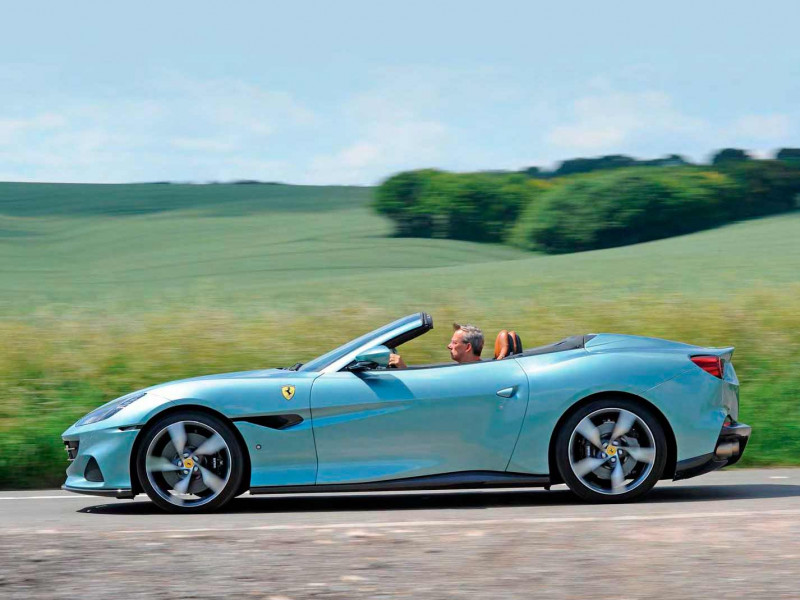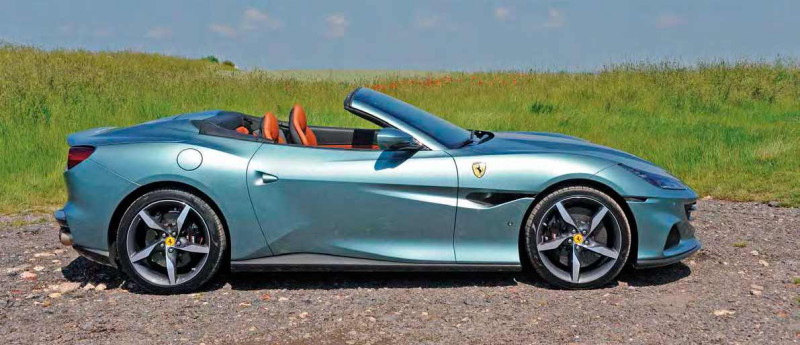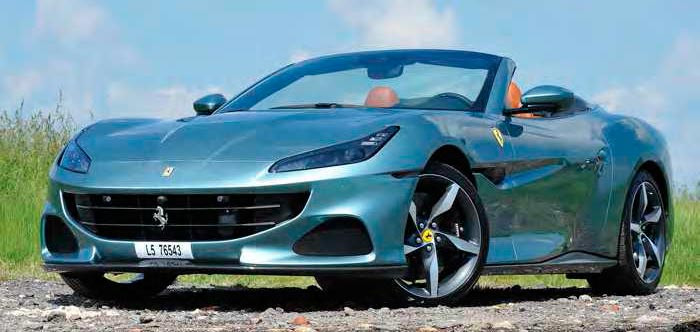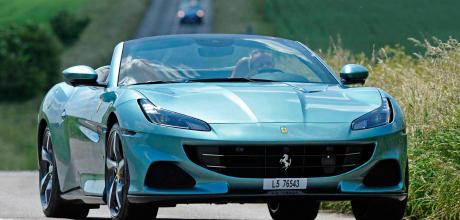2022 Ferrari Portofino M
Dial M for Modified The addition of an ‘M’ to the Portofino signifies that it’s received the same under-the-skin upgrades as the Roma coupe. Does it now drive as well as its fixed-roof sister? Story by Chris Rees. Photography by Michael Ward.
FERRARI PORTOFINO M
UK road test – is it as good as the Roma?
Isn’t it peculiar that North-South divides define the cultural landscapes of both Britain and Italy? In Britain, northerners proclaim their friendliness and robustness of spirit; southerners regard life ‘oop north’ as simply grim; and the beautiful South is viewed by those in the north as unsmiling and populated by ‘softies’. Then there’s the vernacular: a bit like Brits and Americans, north and south are separated by a common language. But if you think the divide is big in Britain, try going to Italy, where the chasm between north and south is so yawning that they feel like entirely different countries. All this preamble is for a reason, I promise. Let’s adopt the fancy that Ferrari’s Portofino model – named after the spectacularly beautiful resort on the Ligurian coast – represents the north of Italy. We can only imagine how its northern nose has been put out of joint by the arrival on the scene of Ferrari’s new southern upstart, the Roma coupe – named after the city that was awarded, with some consternation in the northern city of Milan, the status of capital of Italy.

This north-south pairing feels a bit like a rivalry of twins – Romulus and Remus, perhaps? – with the Roma labelled by some as merely a coupe version of the Portofino. However, that’s not the case at all. While the Roma does share the same basic platform, it has 20hp more power, an extra gear ratio, extra modes on the manettino switch and more sophisticated chassis electronics. Its styling shares absolutely nothing with the Portofino either.
In truth, as Ferrari well knows, the divide between coupe and convertible customers is every bit as chasmic as north versus south. You’re basically in one camp or the other, and never the twain shall meet.

If I were a Portofino customer, I would definitely have been harbouring some annoyance that the Roma boasts a superior specification. Well, after four years on sale the story has changed for the ’Fino. With the simple expedient of adding an ‘M’ to the Portofino’s badge, the drop-top has inherited most of what makes the Roma better.
Incidentally, Ferrari’s ‘M’ (for Modified) badge has traditionally signified mid-life improvements, with such forebears as the F512 M (1994), 456M GT (1998) and 575M Maranello (2002).
Now I’m about to climb on board to see just how much the gulf between Roma and Portofino has been closed. Let’s start with what’s under the bonnet. The Roma’s 3.9-litre V8 twin-turbo engine now makes its way into the Portofino M. It develops 620hp (20hp more than before) thanks to uprated intake and exhaust systems, higher-lift cams and a new sensor in the turbo. Firing up the beast produces that familiar V8 turbo rumble. Do I sense a touch of extra brawn in the soundtrack? It’s subdued rather than screaming, probably well judged given the car’s grand touring role. The exhaust has had its silencers removed and new bypass valves fitted and yes, it does sound very nice, although I must say I would enjoy some more crackle on the overrun. In terms of pace, the ‘M’ adds a small but noticeable dose of extra sparkle. The quoted 0-62mph time is 3.45 seconds – only a minuscule 0.05 second faster – but the more telling figure is the 0-124mph time of 9.8 seconds, a full second faster than the pre-M car. Equally impressive is how flexible the revised V8 feels, easily capable of hauling you all the way from 1000rpm to peak revs with ease.

Front and rear ends are lightly restyled but it’s under the skin that the big changes happen, transforming the way the Portofino M drives.
Another very noticeable advance is the gearbox. The addition of one extra ratio to the dual-clutch ’box (making eight) belies how much of a leap forwards it is. Gears are changed much more quickly and with extra smoothness. In automatic mode, the gearbox generally behaves itself extremely well, although sometimes it hunts around for the correct gear on a light throttle. Personally I find I derive much more fun using the manual paddle shifters.
There are now five driving modes on the manettino: Wet, Comfort, Sport, Race and ESC-Off. There doesn’t feel like there’s much difference between Comfort and Sport modes, nor could I discern any significant change in exhaust note between the five modes. That ‘Race’ mode therefore proves far too tempting: it sharpens up the gearshifts, whether you’re in automatic or manual, and also gives you a much looser rear end to play with.
Ferrari’s trademark ‘bumpy road’ mode button doesn’t really improve ride quality but instead allows you to push a little harder when bumps in the tarmac might otherwise deflect your course. Not that the ride quality is harsh at all: it is very much ideal for the car’s grand touring role, whatever drive mode you’re in.

No question, the ‘M’ now feels much sportier around corners. Thanks to Side Slip Control (SSC) with Ferrari Dynamic Enhancer (FDE) and a tweaked rear differential, you can really hurl the Portofino M into bends with confidence. The feeling of what the car is doing underneath you is transmitted clearly and the SSC/FDE combo allows you to play with the rear end without ever losing control. Race mode definitely feels the best for handling feel. Ferraris says that traction on low-grip surfaces has improved, but on the rare sunny summer’s day of our test drive I didn’t get to test this claim.
One thing I would say is that the front damping does feel quite soft, denuding the overall sense of sharpness. But this isn’t a sports car – that’s not really the point of the Portofino M, which is more about rapid touring ability and less about ultimate handling agility. One other small improvement is the brakes – the carbon-ceramic discs benefit from extra modulation in the pedal to sharpen feedback. One aspect that the Portofino M sadly hasn’t gained from the Roma is the coupe’s engaging cabin and curvaceous digital display. Instead, it’s kept the old Portofino layout basically unchanged. That said, the multi-level dashboard works fine, in particular the large central touchscreen (now with Android Auto and Apple CarPlay) and optional passenger display. The rear seats are still tiny but you can fold them to boost luggage space, while the 18-way adjustable front seats are great thanks to their heating, ventilation and neck warmer. Another thing that hasn’t changed is the roof, which is a good thing since it’s a brilliant bit of hardware, folding away in a matter of seconds at the touch of a button.
It’s also tricky to spot much of a difference in terms of styling, at least at first glance. There’s a new front bumper with redesigned air intakes, a new aluminium-slatted grille and reshaped side air exits. At the rear, the bumper is more streamlined and the diffuser is now a separate item (available in carbonfibre if you want), while the 20-inch forged alloy wheels are also new.
VERDICT
The addition of the letter ‘M’ to the Portofino has effectively united ‘north’ and ‘south’ – in other words, the Portofino M marks a clear leap forwards by benefiting from most of the changes that make the Roma coupe so desirable. Yes, it doesn’t look very different but in terms of the way it drives, the upgrades really do make it feel like a new car: sportier yet easier to use, while being more agile, more predictable and overall a more fun experience. It’s also very convincing as a 2+2 that works well as a coupe with the top up and a pukka convertible when the top is lowered.
Another area where the Roma and Portofino have come closer together is cost. The M’s price tag has leapt up by almost £10k versus the old Portofino to £175,360. That makes it more expensive than the £173,214 Roma. But like oil and water, like north and south, convertible and coupe buyers are utterly distinct groups. And the Portofino M very much makes its own statement. If you want one, be prepared to join the queue: apparently there’s a nine-month waiting list.
TECHNICAL SPECIFICATIONS 2022 Ferrari Portofino M
- ENGINE: 3855cc V8-cyl twin-turbo
- MAX POWER: 620bhp at 5750-7500rpm
- MAX TORQUE: 760Nm (561lb ft) at 3000-5750rpm
- TRANSMISSION: 8-speed dual-clutch semi-auto, rear-wheel drive
- BRAKES: Carbon-ceramic 390mm x 34mm (front), 360mm x 32mm (rear)
- TYRES: 245/35 ZR20 (front) 285/35 ZR20 (rear)
- DIMENSIONS: 4594mm (L), 1938mm (W), 1318m (H)
- WEIGHT: 1545kg (dry), 1664kg (kerb)
- MAX SPEED: 199mph
- 0-62MPH: 3.45 sec
- PRICE: £175,360
‘Race mode proves far too tempting: it sharpens up the gearshifts and gives you a much looser rear end to play with’


